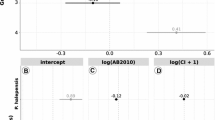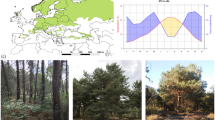Abstract
This study attempted to explain the variation in growth of individual trees in a naturally regenerated, even-agedLarix sibirica stand using indices that represented the competitive and cooperative interactions among neighboring trees. These interaction indices and DBH were used in stepwise multiple regression procedures to model the growth of individual trees. However, when the data from all trees were used, DBH was the only factor accepted in the growth model. Since DBH can be influenced by the cumulative effect of past interaction and other environmental factors, we stratified the stand into three height strata and repeated the stepwise procedure for each stratum to remove the cumulative effect represented by DBH. Several competition and/or cooperation indices were accepted in growth models of the lower, middle and upper strata. In each stratum, the residual mean square of the growth model was smaller than that of all strata. These facts suggested that height stratification was generally successful in reducing the cumulative effect of past interaction and other factors. The cooperation indices that suggested protection from wind stress by neighboring trees was a significant variable in the growth models of all three strata. This demonstrated that cooperative interaction should be considered in the explanation of variation in tree growth in dry and windy climates such as the present study region.
Similar content being viewed by others
Literature cited
Ashby, W.C., Kolar, C.A., Hendricks, T.R., and Phares, R.E. (1979) Effects of shaking and shading on growth of three hardwood species. Forest Sci. 25: 212–216.
Bella, I.E. (1971) A new competition model for individual trees. Forest Sci. 17: 364–372.
Biging, G.S. and Dobbertin, M. (1992) A comparison of distance-dependent competition measures for height and basal area growth of individual conifer trees. Forest Sci. 38: 695–720.
Biging, G.S. and Dobbertin, M. (1995) Evaluation of competition indices in individual tree growth models. Forest Sci. 41: 360–377.
Brand, D.G. and Magnussen, S. (1998) Asymmetric, two-sided competition in even-aged monocultures of red pine. Can. J. For. Res. 18: 901–910.
Brunner, A. and Nigh, G. (2000) Light absorption and bole volume growth of individual Douglas-fir. Tree Physiol. 20: 323–332.
Clark, P.J. and Evans, F.C. (1954) Distance to nearest neighbor as a measure of spatial relationships in population. Ecology 35: 445–453.
Daniels, R.F. (1976) Simple competition indices and their correlation with annual loblolly pine tree growth. Forest Sci. 22: 454–456.
Daniels, R.F., Burkhart, H.E., and Clason, T.R. (1986) A comparison of competition measures for predicting growth of loblolly pine trees. Can. J. For. Res. 16: 1230–1237.
Deluis, D., Ravebtos, J., Cortina, J. Moro, M.J., and Bellot, J. (1998) Assessing components of a competition index to predict growth in an even-agedPinus nigra stand. New Forest 15: 223–242.
Hozumi, K., Koyama, H., and Kira, T. (1955) Intraspecific competition among higher plants (V) A preliminary account on the interaction between adjacent individuals. J. Inst. Polytech. Osaka City Univ. D6: 121–130.
Inoue, A., Mizoue, N., Yoshida, S., and Imada, M. (1998) A new method for analyzing forest stratification based on discriminant criteria. J. For. Plann. 4: 35–38.
Larson, P.R. (1965) Stem form of young larix as influenced by wind and pruning. Forest Sci. 11: 412–424.
Lorimer, C.G. (1983) Tests of age-independent competition indices for individual trees in natural hardwood stands. For. Ecol. Manage. 6: 343–360.
Mithen, R., Harper, J.H., and Weiner, J. (1984) Growth and mortality of individual plants as a function of “available area”. Oecologia 62: 57–60.
Muramoto, Y., Ito, S., and Nogami, K. (1998) Edge tree decline of hinoki (Chamaecyparis obtuse Endlicher) mature stands after typhoon damages. Jpn. J. For. Environ. 40: 27–32.
Neter, J., Kutner, M.H., Nachtsheim, C.J., and Wasserman, W. (1996) Applied linear statistical models, 4th ed. 1408pp, Irwin, Inc., Chicago.
Schwinning, S. and Weiner, J. (1998) Mechanisms determining the degree of size asymmetry in competition among plants. Oecologia 113: 447–455.
Seiwa, K. and Kikuzawa, K. (1987) Changes of spatial dispersions in trees with same size during the development of anAbies sachalinensis stand. J. Jpn. For. Soc. 69: 465–471. (in Japanese)
Spurr, S.H. (1962) A measure of point density. Forest Sci. 8: 85–96.
Tatsuhara, S. (1992) An integrated description of stand growth and tree growth in pure even-aged closed stands. J. Jpn. For. Soc. 74: 28–36.
Taylor, P.J., Nuberg, I.K., and Hatton, T.J. (2001) Enhanced transpiration in response to wind effects at the edge of a blue gum (Eucalyptus globulus) plantation. Tree Physiol. 21: 403–408.
Tome, M. and Burkhart, H.E. (1989) Distance-dependent competition measures for predicting growth of individual trees. Forest Sci. 35: 816–831.
Watson, A. (2000) Wind-induced forces in the near-surface lateral roots of radiata pine. For. Ecol. Manage. 135: 133–142.
Weiner, J. and Solbrig, O.T. (1984) The meaning and measurement of size hierarchies in plant populations. Oecologia 61: 334–336.
Zenner, E.K. and Hibbs, D.E. (2000) A new method for modeling the heterogeneity of forest structure. For. Ecol. Manage. 129: 75–87.
Author information
Authors and Affiliations
Corresponding author
Additional information
This study was supported with grants from The Nissan Science Foundation, and from the Heiwa Nakajima Foundation.
About this article
Cite this article
Mitsuda, Y., Ito, S. & Takata, K. Effects of competitive and cooperative interaction among neighboring trees on tree growth in a naturally regenerated even-agedLarix sibirica stand in considering height stratification. J For Res 7, 185–191 (2002). https://doi.org/10.1007/BF02763131
Received:
Accepted:
Issue Date:
DOI: https://doi.org/10.1007/BF02763131




